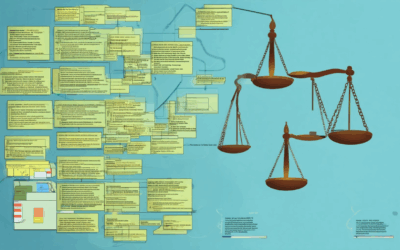Creating a well-structured and effective nonprofit budget is essential for ensuring your organization operates efficiently and stays aligned with its mission. A comprehensive budget plan serves as the foundation for managing resources, tracking expenses, and achieving financial goals. Whether you’re just starting out or looking to refine your approach, understanding how to organize income sources, list expenses, set clear financial objectives, and maintain accurate tracking is crucial for long-term success. This guide will walk you through the key steps to create a nonprofit budget that supports your organization’s vision while fostering flexibility and accountability. By aligning your budget with your nonprofit’s goals, you can ensure that every dollar spent contributes meaningfully to your cause. Read on to discover practical strategies for crafting a nonprofit budget that drives impact and ensures sustainable growth.
Key Takeaways: Igniting Your Nonprofit Strategy with a Comprehensive Budget Plan
- Categorize Income Streams: Efficiently organize donations, grants, and other revenue sources to streamline tracking and management.
- Diversify Expense Categories: Break down costs into clear, manageable sections such as program, administrative, marketing, and travel expenses for enhanced oversight.
- Define Financial Objectives: Set clear targets for revenue, spending limits, and reserve funds to guide your nonprofit’s financial strategy.
- Implement Tracking Systems: Utilize financial software like QuickBooks for real-time monitoring and efficient adjustments to your budget.
- Regularly Review and Adjust: Conduct monthly financial check-ins to monitor progress and make necessary tweaks for optimal financial performance.
- Maintain Compliance and Transparency: Adhere to legal requirements and share detailed financial reports with your board and stakeholders to build trust.
- Collaborate with Professionals: Engage with finance teams, auditors, and stakeholders to ensure thorough reviews and accurate budget preparation.
- Prepare for Uncertainties: Allocate funds for unforeseen expenses to maintain financial stability and adaptability in your nonprofit operations.
- Enhance Skills with Resources: Leverage educational materials and tools to continuously improve your budgeting capabilities and ensure effective financial management.

How to Effectively Create a Comprehensive Nonprofit Budget
Creating a well-organized and comprehensive nonprofit budget requires careful planning and attention to detail. Below is a step-by-step guide to help you organize income sources, list expenses, set financial goals, and ensure accurate tracking and adjustments over time.
1. Organize Income Sources
Your nonprofit’s budget begins with understanding where the funds come from. Categorize income sources into distinct groups:
- Donations and Grants: Identify individual donors, foundation grants, and corporate sponsorships.
- Program Fees: Revenue generated from programs, events, or services offered.
- Membership Dues: Income from members paying annual fees.
- Fundraising Activities: Include proceeds from auctions, galas, or other fundraising events.
2. List Expenses
Expenses are the backbone of your budget, ensuring every dollar is spent wisely. Break them down into manageable categories:
- Program Costs: Costs associated with delivering your core programs or services.
- Administrative Costs: Overhead expenses like office rent, utilities, and personnel.
- Marketing and Outreach: Costs for promotional materials, advertising, and donor engagement.
- Fundraising Expenses: Includes event planning, catering, and promotional items.
- Travel and Professional Development: Costs for staff travel and training.
3. Set Financial Goals
Define clear financial objectives to guide your budgeting process:
- Revenue Target: Establish a total amount you aim to raise during the fiscal year.
- Expense Limit: Define the maximum allowable expenses for each category.
- Reserve Fund: Set aside a portion of your income for emergencies or future projects.
4. Implement Tracking and Adjustments
Regular monitoring is essential for staying on track and making necessary adjustments:
- Use Financial Software: Leverage tools like QuickBooks or nonprofit-specific software for accurate tracking.
- Monthly Reviews: Conduct regular financial check-ins to review progress toward goals.
- Adjustments: Make changes to your budget as needed based on actual income and expenditure trends.
5. Ensure Accountability and Compliance
Transparency and adherence to legal requirements are critical to maintaining trust:
- Financial Reporting: Provide detailed reports to your board and stakeholders.
- Compliance: Stay informed about IRS regulations and other legal requirements for nonprofits.
- Internal Controls: Implement measures to prevent fraud and ensure accurate record-keeping.
6. Collaborate and Seek Expertise
Involve key stakeholders and professionals to enhance the accuracy and reliability of your budget:
- Finance Team: Work closely with your organization’s financial experts.
- Auditors: Engage external auditors for a thorough review of your financial records.
- Stakeholders: Share your budget with key partners, donors, and board members for feedback.
By following these steps, you can create a comprehensive nonprofit budget that aligns with your organizational goals and ensures financial transparency and accountability. For further insights, explore NPO Expert’s resources on fundraising strategies and compliance guidelines tailored for nonprofit organizations.
How to Effectively Create a Comprehensive Nonprofit Budget
Creating a well-organized and comprehensive nonprofit budget requires careful planning and attention to detail. Below is a step-by-step guide to help you organize income sources, list expenses, set financial goals, and ensure accurate tracking and adjustments over time.
1. Organize Income Sources
Your nonprofit’s budget begins with understanding where the funds come from. Categorize income sources into distinct groups:
- Donations and Grants: Identify individual donors, foundation grants, and corporate sponsorships.
- Program Fees: Revenue generated from programs, events, or services offered.
- Membership Dues: Income from members paying annual fees.
- Fundraising Activities: Include proceeds from auctions, galas, or other fundraising events.
2. List Expenses
Expenses are the backbone of your budget, ensuring every dollar is spent wisely. Break them down into manageable categories:
- Program Costs: Costs associated with delivering your core programs or services.
- Administrative Costs: Overhead expenses like office rent, utilities, and personnel.
- Marketing and Outreach: Costs for promotional materials, advertising, and donor engagement.
- Fundraising Expenses: Includes event planning, catering, and promotional items.
- Travel and Professional Development: Costs for staff travel and training.
3. Set Financial Goals
Define clear financial objectives to guide your budgeting process:
- Revenue Target: Establish a total amount you aim to raise during the fiscal year.
- Expense Limit: Define the maximum allowable expenses for each category.
- Reserve Fund: Set aside a portion of your income for emergencies or future projects.
4. Implement Tracking and Adjustments
Regular monitoring is essential for staying on track and making necessary adjustments:
- Use Financial Software: Leverage tools like QuickBooks or nonprofit-specific software for accurate tracking.
- Monthly Reviews: Conduct regular financial check-ins to review progress toward goals.
- Adjustments: Make changes to your budget as needed based on actual income and expenditure trends.
5. Ensure Accountability and Compliance
Transparency and adherence to legal requirements are critical to maintaining trust:
- Financial Reporting: Provide detailed reports to your board and stakeholders.
- Compliance: Stay informed about IRS regulations and other legal requirements for nonprofits.
- Internal Controls: Implement measures to prevent fraud and ensure accurate record-keeping.
6. Collaborate and Seek Expertise
Involve key stakeholders and professionals to enhance the accuracy and reliability of your budget:
- Finance Team: Work closely with your organization’s financial experts.
- Auditors: Engage external auditors for a thorough review of your financial records.
- Stakeholders: Share your budget with key partners, donors, and board members for feedback.
By following these steps, you can create a comprehensive nonprofit budget that aligns with your organizational goals and ensures financial transparency and accountability. For further insights, explore NPO Expert’s resources on fundraising strategies and compliance guidelines tailored for nonprofit organizations.

How to Effectively Create a Comprehensive Nonprofit Budget
Creating a well-organized and comprehensive nonprofit budget requires careful planning and attention to detail. Below is a step-by-step guide to help you organize income sources, list expenses, set financial goals, and ensure accurate tracking and adjustments over time.
1. Organize Income Sources
Your nonprofit’s budget begins with understanding where the funds come from. Categorize income sources into distinct groups:
- Donations and Grants: Identify individual donors, foundation grants, and corporate sponsorships.
- Program Fees: Revenue generated from programs, events, or services offered.
- Membership Dues: Income from members paying annual fees.
- Fundraising Activities: Include proceeds from auctions, galas, or other fundraising events.
2. List Expenses
Expenses are the backbone of your budget, ensuring every dollar is spent wisely. Break them down into manageable categories:
- Program Costs: Costs associated with delivering your core programs or services.
- Administrative Costs: Overhead expenses like office rent, utilities, and personnel.
- Marketing and Outreach: Costs for promotional materials, advertising, and donor engagement.
- Fundraising Expenses: Includes event planning, catering, and promotional items.
- Travel and Professional Development: Costs for staff travel and training.
3. Set Financial Goals
Define clear financial objectives to guide your budgeting process:
- Revenue Target: Establish a total amount you aim to raise during the fiscal year.
- Expense Limit: Define the maximum allowable expenses for each category.
- Reserve Fund: Set aside a portion of your income for emergencies or future projects.
4. Implement Tracking and Adjustments
Regular monitoring is essential for staying on track and making necessary adjustments:
- Use Financial Software: Leverage tools like QuickBooks or nonprofit-specific software for accurate tracking.
- Monthly Reviews: Conduct regular financial check-ins to review progress toward goals.
- Adjustments: Make changes to your budget as needed based on actual income and expenditure trends.
5. Ensure Accountability and Compliance
Transparency and adherence to legal requirements are critical to maintaining trust:
- Financial Reporting: Provide detailed reports to your board and stakeholders.
- Compliance: Stay informed about IRS regulations and other legal requirements for nonprofits.
- Internal Controls: Implement measures to prevent fraud and ensure accurate record-keeping.
6. Collaborate and Seek Expertise
Involve key stakeholders and professionals to enhance the accuracy and reliability of your budget:
- Finance Team: Work closely with your organization’s financial experts.
- Auditors: Engage external auditors for a thorough review of your financial records.
- Stakeholders: Share your budget with key partners, donors, and board members for feedback.
By following these steps, you can create a comprehensive nonprofit budget that aligns with your organizational goals and ensures financial transparency and accountability. For further insights, explore NPO Expert’s resources on fundraising strategies and compliance guidelines tailored for nonprofit organizations.

How to Effectively Create a Comprehensive Nonprofit Budget
Creating a well-organized and comprehensive nonprofit budget requires careful planning and attention to detail. Below is a step-by-step guide to help you organize income sources, list expenses, set financial goals, and ensure accurate tracking and adjustments over time.
1. Organize Income Sources
Your nonprofit’s budget begins with understanding where the funds come from. Categorize income sources into distinct groups:
- Donations and Grants: Identify individual donors, foundation grants, and corporate sponsorships.
- Program Fees: Revenue generated from programs, events, or services offered.
- Membership Dues: Income from members paying annual fees.
- Fundraising Activities: Include proceeds from auctions, galas, or other fundraising events.
2. List Expenses
Expenses are the backbone of your budget, ensuring every dollar is spent wisely. Break them down into manageable categories:
- Program Costs: Costs associated with delivering your core programs or services.
- Administrative Costs: Overhead expenses like office rent, utilities, and personnel.
- Marketing and Outreach: Costs for promotional materials, advertising, and donor engagement.
- Fundraising Expenses: Includes event planning, catering, and promotional items.
- Travel and Professional Development: Costs for staff travel and training.
3. Set Financial Goals
Define clear financial objectives to guide your budgeting process:
- Revenue Target: Establish a total amount you aim to raise during the fiscal year.
- Expense Limit: Define the maximum allowable expenses for each category.
- Reserve Fund: Set aside a portion of your income for emergencies or future projects.
4. Implement Tracking and Adjustments
Regular monitoring is essential for staying on track and making necessary adjustments:
- Use Financial Software: Leverage tools like QuickBooks or nonprofit-specific software for accurate tracking.
- Monthly Reviews: Conduct regular financial check-ins to review progress toward goals.
- Adjustments: Make changes to your budget as needed based on actual income and expenditure trends.
5. Ensure Accountability and Compliance
Transparency and adherence to legal requirements are critical to maintaining trust:
- Financial Reporting: Provide detailed reports to your board and stakeholders.
- Compliance: Stay informed about IRS regulations and other legal requirements for nonprofits.
- Internal Controls: Implement measures to prevent fraud and ensure accurate record-keeping.
6. Collaborate and Seek Expertise
Involve key stakeholders and professionals to enhance the accuracy and reliability of your budget:
- Finance Team: Work closely with your organization’s financial experts.
- Auditors: Engage external auditors for a thorough review of your financial records.
- Stakeholders: Share your budget with key partners, donors, and board members for feedback.
By following these steps, you can create a comprehensive nonprofit budget that aligns with your organizational goals and ensures financial transparency and accountability. For further insights, explore NPO Expert’s resources on fundraising strategies and compliance guidelines tailored for nonprofit organizations.
How to Effectively Create a Comprehensive Nonprofit Budget
Creating a well-organized and comprehensive nonprofit budget requires careful planning and attention to detail. Below is a step-by-step guide to help you organize income sources, list expenses, set financial goals, and ensure accurate tracking and adjustments over time.
1. Organize Income Sources
Your nonprofit’s budget begins with understanding where the funds come from. Categorize income sources into distinct groups:
- Donations and Grants: Identify individual donors, foundation grants, and corporate sponsorships.
- Program Fees: Revenue generated from programs, events, or services offered.
- Membership Dues: Income from members paying annual fees.
- Fundraising Activities: Include proceeds from auctions, galas, or other fundraising events.
2. List Expenses
Expenses are the backbone of your budget, ensuring every dollar is spent wisely. Break them down into manageable categories:
- Program Costs: Costs associated with delivering your core programs or services.
- Administrative Costs: Overhead expenses like office rent, utilities, and personnel.
- Marketing and Outreach: Costs for promotional materials, advertising, and donor engagement.
- Fundraising Expenses: Includes event planning, catering, and promotional items.
- Travel and Professional Development: Costs for staff travel and training.
3. Set Financial Goals
Define clear financial objectives to guide your budgeting process:
- Revenue Target: Establish a total amount you aim to raise during the fiscal year.
- Expense Limit: Define the maximum allowable expenses for each category.
- Reserve Fund: Set aside a portion of your income for emergencies or future projects.
4. Implement Tracking and Adjustments
Regular monitoring is essential for staying on track and making necessary adjustments:
- Use Financial Software: Leverage tools like QuickBooks or nonprofit-specific software for accurate tracking.
- Monthly Reviews: Conduct regular financial check-ins to review progress toward goals.
- Adjustments: Make changes to your budget as needed based on actual income and expenditure trends.
5. Ensure Accountability and Compliance
Transparency and adherence to legal requirements are critical to maintaining trust:
- Financial Reporting: Provide detailed reports to your board and stakeholders.
- Compliance: Stay informed about IRS regulations and other legal requirements for nonprofits.
- Internal Controls: Implement measures to prevent fraud and ensure accurate record-keeping.
6. Collaborate and Seek Expertise
Involve key stakeholders and professionals to enhance the accuracy and reliability of your budget:
- Finance Team: Work closely with your organization’s financial experts.
- Auditors: Engage external auditors for a thorough review of your financial records.
- Stakeholders: Share your budget with key partners, donors, and board members for feedback.
By following these steps, you can create a comprehensive nonprofit budget that aligns with your organizational goals and ensures financial transparency and accountability. For further insights, explore NPO Expert’s resources on fundraising strategies and compliance guidelines tailored for nonprofit organizations.

How to Effectively Create a Comprehensive Nonprofit Budget
To create a well-organized and effective nonprofit budget, follow these organized steps:
- Identify Income Sources
- Compile a list of all revenue streams, including donations, grants, membership fees, and event proceeds.
- Categorize income sources for clarity, such as individual donations vs. corporate grants.
- List Expenses
- Break down operational costs into categories like program expenses, salaries, office supplies, marketing, and utilities.
- Separate administrative costs from program-specific expenditures for clearer oversight.
- Set Financial Goals
- Define measurable objectives, including total revenue targets, expense limitations, and reserve fund allocations.
- Establish short-term and long-term financial aims aligned with organizational objectives.
- Implement Tracking and Adjustments
- Utilize financial software for accurate tracking and real-time monitoring.
- Schedule regular budget reviews, such as monthly or quarterly, to adjust based on performance and needs.
- Ensure Accountability
- Maintain transparency by sharing financial reports with the board and stakeholders.
- Consider publishing reports online to foster donor trust and accountability.
- Compliance and Record-Keeping
- Adhere to legal requirements, including tax filings and audit preparedness.
- Keep financial records for at least seven years to meet regulatory standards.
- Collaborate and Educate
- Involve key stakeholders, such as program directors and development officers, in budget preparation.
- Provide training for the finance team to ensure accuracy and adherence to protocols.
- Consider Contingency Plans
- Allocate funds for unforeseen expenses and develop strategies to manage deficits or surpluses.
- Utilize Tools and Resources
- Explore tools like QuickBooks or nonprofit-specific software to streamline budgeting processes.
- Leverage educational resources and workshops for continuous improvement.
By systematically addressing each component, you can create a robust nonprofit budget that supports organizational growth and accountability.





0 Comments